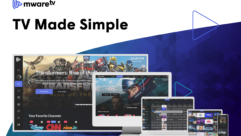Making A Case For Media Streaming
Using streaming media, your clients can provide high-quality communications for about 1.5 cents per minute and eliminate lost time and travel expenses. Debunk the misconceptions and make a case for media streaming as part of your next AV project.
Why stream media?Show them the moneyEnterprise video streamingOvercoming objectionsWhat about the hardware?The bottom line
In a landmark study on the role of vision and other nonverbal aspects of communication called “Silent Messages” published in the early 1970s, Professor Albert Mehrabian concluded that 55 percent of human communications is visual — or put another way, communications without sight is less than half as effective.
Since that time, our reliance as a society on the sense of sight has grown, thanks to the emergence of advanced rich media visual communications systems. Yet many organizations have still been slow to deploy media streaming, despite its many benefits. Why? Some say the technology is too complex, or the cost is too high. Others believe the benefits seem fuzzy. Or maybe it’s because the return on investment is rarely articulated. These are just some of the reasons customers typically cite when dismissing a media streaming solution. But often these reasons are unjustified. Let’s see how systems integrators can prove these theories wrong and make a case for media streaming as part of a comprehensive AV package.
Streaming media is a component of an overall communications strategy that includes face-to-face meetings, telephone calls and conferences, broadcast television, electronic messages, and similar forms of human communications. This is important because the deployment of streaming media rarely requires new infrastructure or significant changes to an organization’s behavior. Rather, streaming is incremental to what most organizations are already doing and provides tremendous communications benefits. But convincing the powers that hold the purse strings may be quite another matter. Let’s explore some of the benefits of media streaming to help serve as ammunition for future sales.
For end-users in markets such as corporate enterprises, educational institutions, government, and even houses of worship, streaming media offers a cost-effective way to meet several key business objectives, including:
- More efficient communications — Streaming media provides unambiguous instant message delivery to the target audience, which may be employees, students, customers, investors, or the entire world.
- Training and education — Employees and customers receive continuous training without the costs, scheduling difficulties, and hassles necessary for classroom sessions.
- Advertising and marketing — Nothing communicates better than sight and sound. Complex messages and demonstrations are best delivered using as many of the five senses as possible.
- Security and monitoring — Streaming video allows you to monitor important or sensitive areas from virtually anywhere in the world.
Streaming media goes well beyond merely improving communications. It fills a basic need to engage multiple senses that were heretofore impossible to truly engage at a reasonable cost.
While these benefits sound good and seem logical, it’s not enough for integrators to make the sale. Let’s face it; most decision-makers want some sort of benchmark to determine whether a streaming initiative makes financial sense.
Usually this means comparing a familiar way of achieving a result against a streaming media proposal and showing a return on investment (ROI) in hard numbers. But because the application of streaming is often an enhancement of a communications strategy that has already proven its ROI, it may be best viewed in terms of cost avoidance — and in terms of leveraging existing investments such as networking infrastructure.
Most customers will want to understand the cost and benefits of using streaming media in their company. To illustrate the ROI in an enterprise, let’s assume an organization wishes to deliver a live 1-hour video stream from the company management to 1,000 workplace desktops once per quarter for the purpose of reporting financial results, maintaining company focus, and delivering company news.
Campus Solution
A one-time purchase of the encoding appliance enables the entire organization to view the live video streams delivered from anywhere the appliance is located. The cost per desktop is simply the cost of the equipment, the cost of the staff to install it (generously calculated at $1,000 in this example), divided by the number of desktops. The cost per hour is the system cost divided by total number of hours the system is used. In this example, it costs the company $1.75 per hour per viewer to pay for the system in one year. The alternative (perhaps what the organization is doing now) may be to have employees leave their work area and travel to a conference room or off-site location. The time lost by employees just walking to a conference room is easily well beyond the one-time expense of a streaming solution.
It’s easy to justify a streaming solution when an organization has remote offices. For the cost of just a few airplane tickets, an organization can deploy streaming video to inform and train remote employees.
Remote Office Solution
In this example, the streaming appliance is sending the live video stream via the public Internet to 100 remote desktops. The recurring cost to stream video to viewers on the public Internet is only $0.015 per minute, about the same as the best telephone rates. In this example, the cost per viewer hour is higher than the enterprise example because there are fewer viewers. The per-viewer recurring cost assumes the customer is using an external service for bandwidth scale, but this cost is eliminated if it has sufficient high-speed Internet access. It should be noted that the cost per viewer per hour includes the equipment purchase price amortized in the first year, making subsequent years practically free. The cost per viewer hour is virtually identical to the enterprise example when the same appliance is used to stream to both the local enterprise and the remote offices at the same time — something today’s technology does with ease.
Obviously, streaming video to remote employees is very cost effective, and it’s hardly worth the effort to calculate the ROI when the alternative is expensive air travel.
There tends to be three categories (the three Cs) of objections to streaming media: cost, complexity, and content.
Cost. Your customer may believe that streaming media is exotic, expensive, or has “hidden costs.” They may be right if you’re proposing to go down a proprietary-solutions path. On the other hand, if you’re proposing a robust, field-proven, virus-proof, standards-based solution, the cost can be quite low. But more importantly, the cost is predictable, and you’re not locked in to a single vendor. Today, a single video appliance can deliver MPEG-2 video to every enterprise desktop and simultaneously deliver MPEG-4 to remote offices and the general public. The cost to deploy streaming media is about the cost of a high-end PC.
Complexity. In the past, the streaming media literature tended to speak in terms of an “event,” such as a webcast, a concert, or a conference. Companies formed that would travel to the event location, set up complex equipment, and manage the technology. Of course, they charge for this service. In fact, a single event could easily cost $50,000 or more.
APPLYING STREAMING MEDIA
A global payments company with one of the most recognized brands in the world, MasterCard International has always used meetings to disseminate information and promote real-time interaction between employees and executives. But this can get a bit tricky when you consider that the company has approximately 4,000 employees spread across more than 47 offices around the world. Gathering people together in one location is not only time consuming but also expensive and impractical at times.
Needing a more efficient and cost-effective way to communicate with its employees while preserving the personal nature of face-to-face meetings, MasterCard turned to Seattle-based RealNetworks for a media streaming solution to its internal communication challenges.
After implementing RealNetworks streaming media technology, MasterCard International recently integrated its European organization into the parent company. To celebrate this groundbreaking event, the company held a global webcast in which participants around the world were networked together via live streaming video and audio. Thousands of employees joined the event via their desktops or by telecommuting. During the session, employees could see and hear their colleagues, send emails, ask questions in real time, and even participate in a worldwide toast. For individuals viewing an archived or live event at speeds of 56 Kb/s and beyond, for those working off-site, and for centrally located groups, the technology delivered steady, uninterrupted video and audio. In the past, a traditional company meeting could have only accommodated about 400 to 500 employees at one time. Now the entire company base can see and hear the same messages.
“By employing video streaming, we’re able to put a face and personality behind the message, which helps employees understand management reasoning and logic,” says Linda Locke, vice president of global communications at MasterCard International.
As far as return on investment goes, MasterCard is very pleased with the results. In the past, numerous meetings called for renting halls and equipment, arranging transportation, providing food and accommodations, coordinating busy schedules, and disrupting business in general. By deploying RealNetworks technology, MasterCard has reduced meeting costs by more than 65 percent.
After a recent face-to-face meeting using the new media streaming solution, participants were asked for feedback on the technology. In response, 100 percent of participants agreed that streaming video was a good medium for company-wide meetings. In addition, 100 percent also rated the video and audio quality as excellent.
“We’ve received very positive feedback from all our employees about the use of video to the desktop,” says Lois Miller, vice president of performance improvement at MasterCard. “[RealNetworks technology] gives us all kinds of flexibility that we did not have in the past.”
Since making the move to media streaming, MasterCard is currently in the process of upgrading to a Helix Universal Server, RealNetworks’ new universal digital media server. This technology is designed to improve scalability and reduce bandwidth costs with an integrated content networking system that provisions live and on-demand content reliably across distributed networks.
Complexity has given way to a high degree of automation and simplicity, allowing virtually anyone to stream audio/video within an enterprise and on the public Internet. Challenges still exist in the networking infrastructure, but these challenges are not dissimilar to ones that a company’s IT staff must overcome with or without streaming media. Streaming media just makes those challenges more apparent. To prove that the complexity is low, you might consider giving a demo.
Content. Streaming media is not an answer; it’s a means to an end. It’s the means to deliver meaningful content to an intended audience for a purpose. That purpose may be to educate, inform, or entertain — the same as it is with conventional television. The difference is that the content is up to the end-user, and of course that the content reaches where conventional television does not — the workplace.
When you think of streaming media in terms of an event, the production value of the content may be a concern. But when you think about casual, daily streaming within an enterprise or to a specific audience, the production values are less worrisome. Live and subsequently stored content may range from the inside of any conference room, training facility, or office to a studio set complete with special effects. Content may be a live classroom lecture, an investor presentation, or a video produced on an offline video editing suite. Content may be a 24/7 live news feed delivered to every desktop, an emergency broadcast channel, a security camera feed, mandated Human Resource training on demand, or an endless variety of demonstrations, lectures, and entertainment.
Like fax machines and telephones, streaming media may be deployed via dedicated appliances or via software/hardware running on a computer. There is no “right” answer, and the right choice will depend on what the end-user is trying to accomplish.
“I’ve never had to reboot my telephone” is often the rallying cry for the appliance promoters. While dedicated appliances are generally more reliable than multi-purpose computers for video (often because of other applications running at the same time), there are other benefits. Appliances tend to be simpler, smaller, portable, and more rugged, and the overall streaming latency (delay) from appliances tends to be lower than PCs deliver. One would not expect to see a PC at the top of a telephone pole, but this could be a comfortable home for a video appliance. On the other hand, the appliance will never provide word processing.
“I can do streaming on my PC by simply installing software” is often the rallying cry for the PC promoters. General-purpose computers can do many things, and processing streaming video is certainly one of them. Unlike an appliance, a PC can be used to create original content and to edit and manipulate audio/video. The list of compression and streaming software choices for the PC is long. Dedicating a PC to streaming, PC proponents claim, turns the PC into an appliance. On the other hand, PCs are subject to user abuse, viruses, and security issues that appliances overcome.
It’s rarely an “either/or” proposition between PCs and streaming appliances in today’s converged world. The choice may be more similar to a decision to add more hard disk space to your PC or to add more hard disk space to your file server. It depends on what the customer is trying to accomplish. The right answer may well be both.
Just like email, the telephone, and other forms of modern communications, streaming media is an invaluable business tool. It can be just as simple and easy, but much more compelling. Once integrators present the numbers and make the business case, the best way to prove that streaming media is ready for prime time is to demonstrate it.
Rich Mavrogeanes is the founder and president of VBrick Systems, Inc. He can be reached at [email protected].










